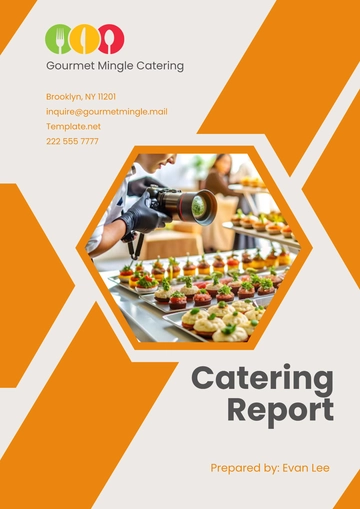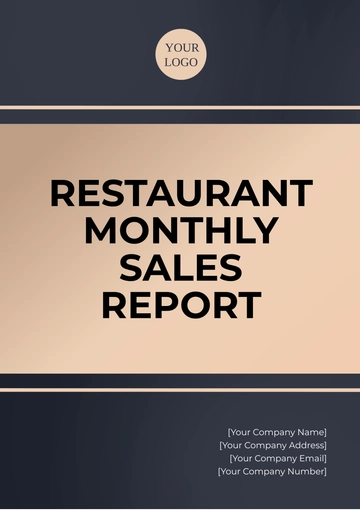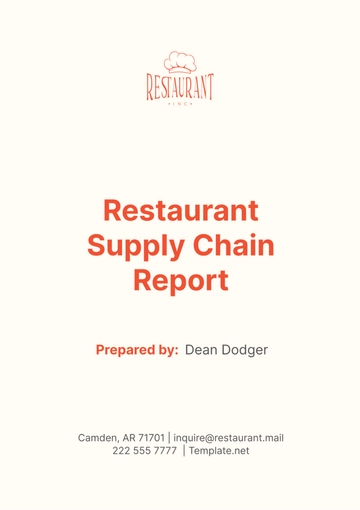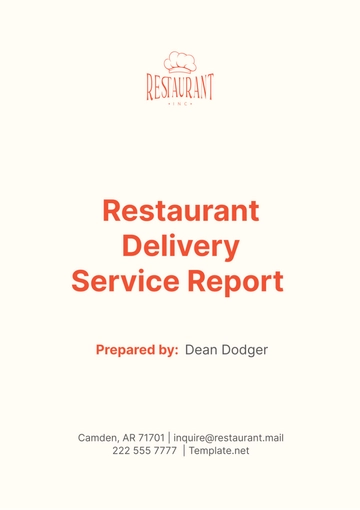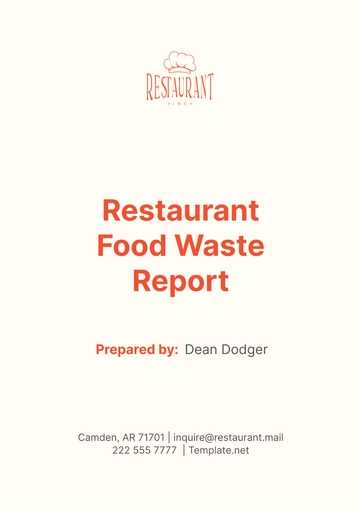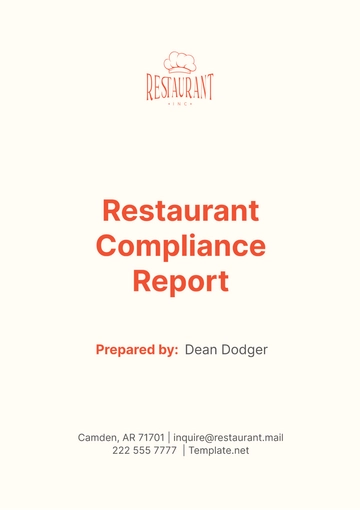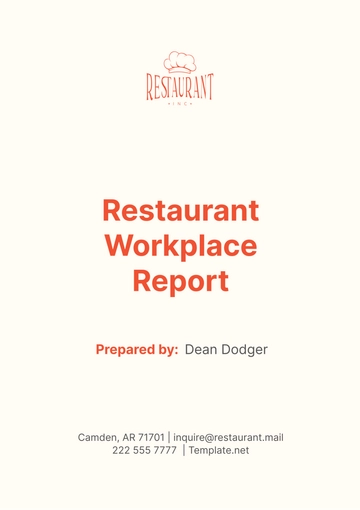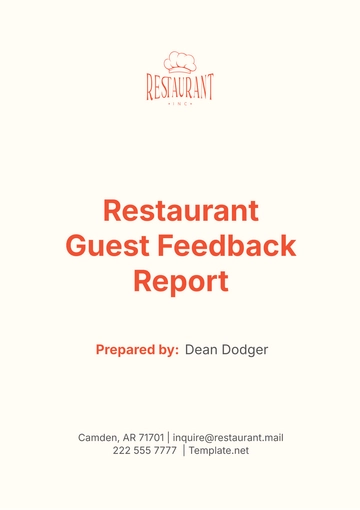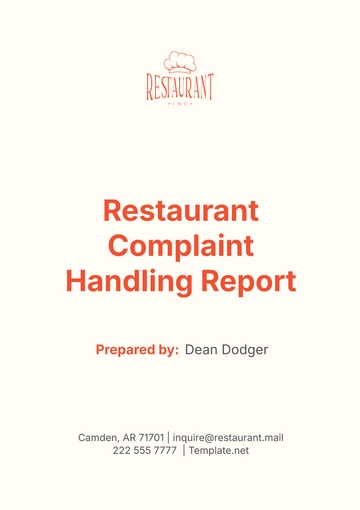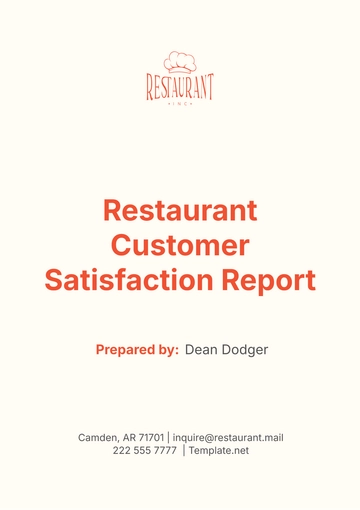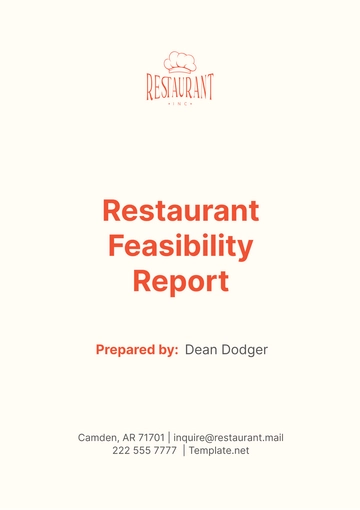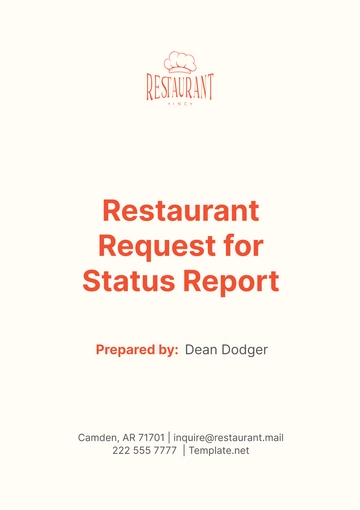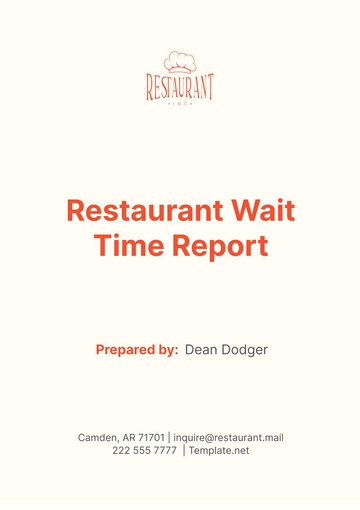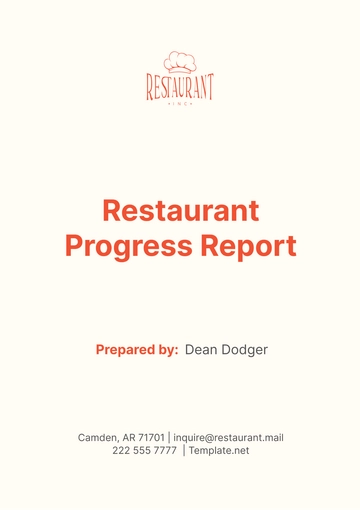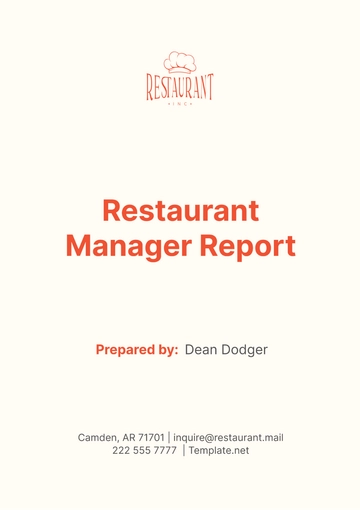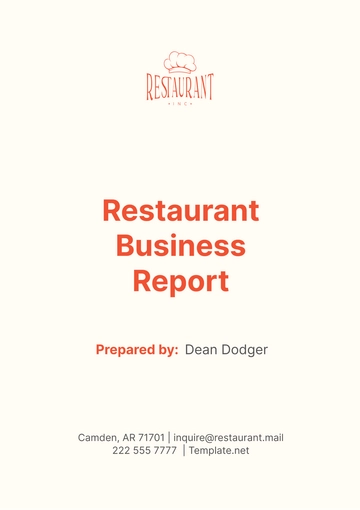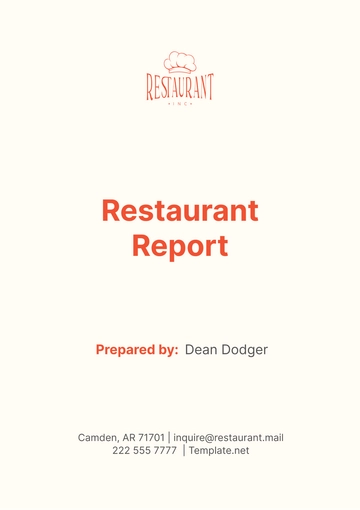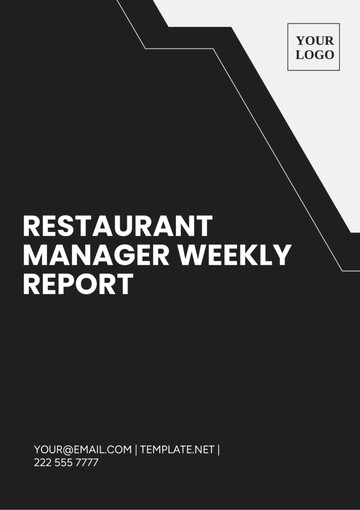Free Restaurant Delivery Service Report
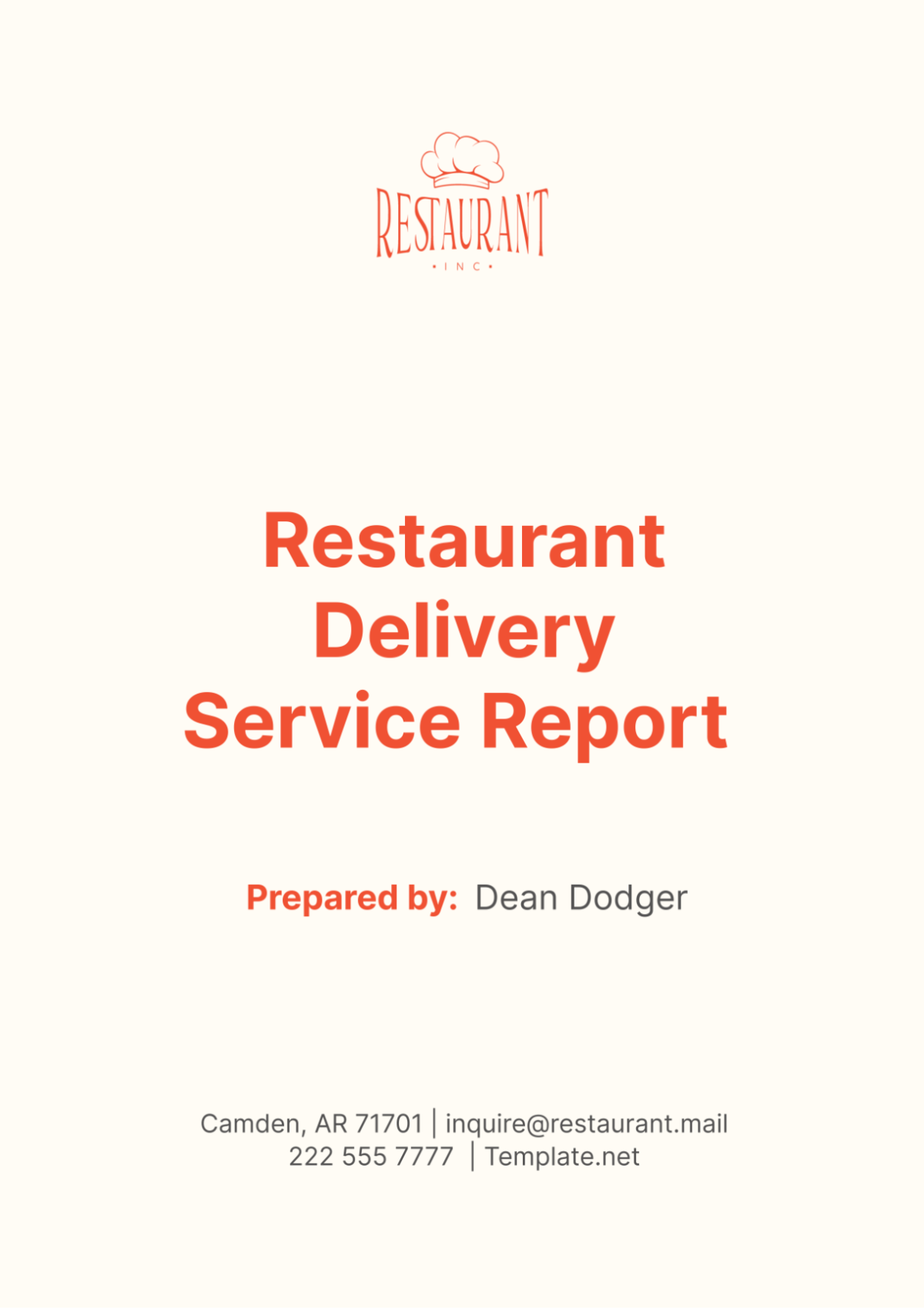
I. Executive Summary
The delivery service landscape has significantly transformed in recent years, especially for the restaurant industry. This report provides a comprehensive analysis of the delivery service operations at [Your Company Name], offering insights into market trends, operational performance, financial impacts, and strategic recommendations for enhancing our delivery capabilities. Key findings reveal a growing demand for delivery services, with substantial opportunities for revenue growth and customer satisfaction improvements. We recommend leveraging technology, optimizing delivery operations, and enhancing marketing strategies to stay competitive and meet consumer demands.
II. Introduction
A. Purpose of the Report
The purpose of this report is to analyze the current state of the delivery service at [Your Company Name], evaluate its performance, and identify opportunities for improvement. This analysis aims to provide actionable recommendations to enhance service quality, operational efficiency, and profitability.
B. Scope of the Analysis
The scope of this report includes a detailed examination of the market environment, our current delivery service model, operational performance metrics, and financial analysis. It also covers technology infrastructure, marketing strategies, and customer feedback.
C. Methodology Used
The methodology for this report involves a combination of qualitative and quantitative research methods. Data was collected from internal company records, customer surveys, market research reports, and competitive analysis. Statistical tools were used to analyze performance metrics and financial data, while qualitative insights were derived from customer feedback and industry expert interviews.
III. Market Analysis
A. Overview of the Current Market for Restaurant Delivery Services
The restaurant delivery market has experienced rapid growth, driven by changing consumer preferences and advancements in technology. According to a recent study by Statista, the global online food delivery market is projected to reach $151.5 billion by [Year], growing at a compound annual growth rate (CAGR) of 9.8%.
B. Competitive Landscape
The competitive landscape is dominated by major players such as Uber Eats, DoorDash, and Grubhub, along with numerous local and regional delivery services. These platforms have significantly lowered the barrier to entry for restaurants but also increased competition.
Competitor | Market Share (%) | Key Strengths |
|---|---|---|
Uber Eats | 30.2 | Extensive reach, strong brand |
DoorDash | 27.8 | User-friendly app, fast delivery |
Grubhub | 16.7 | Large customer base, loyalty programs |
C. Consumer Trends and Preferences
Consumers increasingly prefer the convenience of home delivery. A survey by Deloitte found that 61% of consumers order delivery at least once a week. Key preferences include:
Fast delivery times (preferred by 78% of respondents)
Diverse menu options (preferred by 65%)
Contactless delivery (preferred by 55%)
D. Key Market Drivers and Challenges
Drivers:
Technological advancements in ordering and delivery systems
Increased consumer demand for convenience
Growth in urban populations
Challenges:
High competition leads to thin margins
Logistical complexities and costs
Regulatory compliance and health safety concerns
IV. Delivery Service Overview
A. Description of the Current Delivery Service Model
[Your Company Name] currently utilizes a hybrid delivery model, combining in-house delivery personnel with partnerships with major third-party platforms like Uber Eats and DoorDash. This model allows us to maximize reach while maintaining control over service quality for direct orders.
B. Partnerships with Delivery Platforms
We have strategic partnerships with multiple delivery platforms, each providing access to a broad customer base and advanced delivery logistics.
Platform | Commission Rate (%) | Average Delivery Time (mins) | Customer Rating |
|---|---|---|---|
Uber Eats | 30 | 35 | 4.7 |
DoorDash | 25 | 30 | 4.5 |
Grubhub | 20 | 40 | 4.3 |
C. In-House Delivery Operations
Our in-house delivery team comprises 15 drivers, equipped with GPS tracking and mobile POS systems. This allows us to offer faster and more reliable service for orders placed directly through our website and app.
D. Menu Offerings for Delivery
We offer a curated menu optimized for delivery, ensuring that all items maintain quality and freshness during transit. Popular items include our signature burgers, pasta dishes, and specialty desserts.
Category | Top Items | Average Order Value ($) |
|---|---|---|
Burgers | Classic Cheeseburger | 12.50 |
Pasta | Fettuccine Alfredo | 15.00 |
Desserts | Chocolate Lava Cake | 7.00 |
E. Geographic Coverage
Our delivery service extends across a 15-mile radius surrounding each of our three distinct restaurant locations, thereby ensuring that we are able to provide prompt and efficient delivery services to both urban and suburban areas within these zones.
V. Operational Performance
A. Delivery Volume and Growth Trends
Our delivery volume has seen a consistent upward trend over the past three years, with a notable surge during the pandemic. The number of deliveries increased by 45% in [Year] and continued to grow by 30% in [Year].
Year | Total Deliveries | Year-over-Year Growth (%) |
|---|---|---|
[Year] | 20,000 | - |
[Year] | 29,000 | 45 |
[Year] | 37,700 | 30 |
B. Average Delivery Time
The average delivery time for our orders is 32 minutes, which is competitive with industry standards. In-house deliveries average 28 minutes, while third-party platforms average 35 minutes.
Delivery Type | Average Time (mins) |
|---|---|
In-House | 28 |
Third-Party | 35 |
Overall Average | 32 |
C. Customer Satisfaction Metrics
Customer satisfaction is measured through post-delivery surveys and ratings on third-party platforms. Our average customer satisfaction score is 4.6 out of 5, with high ratings for food quality and delivery speed.
Metric | Score (out of 5) |
|---|---|
Food Quality | 4.7 |
Delivery Speed | 4.5 |
Overall Service | 4.6 |
D. Delivery Accuracy and Error Rates
Maintaining high delivery accuracy is crucial for customer satisfaction. Our current error rate, which includes wrong orders and missing items, is 2.5%, which is below the industry average of 3%.
Metric | Rate (%) |
|---|---|
Error Rate | 2.5 |
Industry Average | 3.0 |
VI. Financial Analysis
A. Revenue Generated from Delivery Services
Delivery services have become a significant revenue stream for [Your Company Name]. In [Year], delivery accounted for 35% of total revenue, generating $1.75 million out of the overall $5 million annual revenue. This is a substantial increase from previous years, highlighting the growing importance of our delivery operations.
Year | Delivery Revenue ($) | Total Revenue ($) | Delivery Revenue % |
|---|---|---|---|
[Year] | 1,000,000 | 4,000,000 | 25 |
[Year] | 1,400,000 | 4,500,000 | 31 |
[Year] | 1,750,000 | 5,000,000 | 35 |
B. Cost Analysis
Delivery services involve various costs, including platform commissions, packaging, and labor. In [Year], total delivery-related costs were $875,000, with the largest expense being platform commissions at $525,000.
Cost Category | [Year] Cost ($) | Percentage of Total Costs (%) |
|---|---|---|
Platform Commissions | 525,000 | 60 |
Packaging | 175,000 | 20 |
Labor | 125,000 | 14 |
Miscellaneous | 50,000 | 6 |
C. Profit Margins
Our delivery profit margin in [Year] was 50%, yielding a net profit of $875,000 from delivery services. This margin is competitive and highlights the efficiency of our delivery operations.
Year | Delivery Revenue ($) | Delivery Costs ($) | Net Profit ($) | Profit Margin (%) |
|---|---|---|---|---|
[Year] | 1,000,000 | 600,000 | 400,000 | 40 |
[Year] | 1,400,000 | 770,000 | 630,000 | 45 |
[Year] | 1,750,000 | 875,000 | 875,000 | 50 |
D. Impact on Overall Restaurant Profitability
The integration of delivery services has positively impacted overall profitability. By [Year], the delivery segment's contribution to net profit was 17.5%, up from 10% in [Year].
Year | Total Net Profit ($) | Delivery Net Profit ($) | Delivery Profit Contribution (%) |
|---|---|---|---|
[Year] | 4,000,000 | 400,000 | 10 |
[Year] | 4,500,000 | 630,000 | 14 |
[Year] | 5,000,000 | 875,000 | 17.5 |
VII. Technology and Infrastructure
A. Ordering Systems and Platforms Used
[Your Company Name] utilizes an integrated online ordering system through our website and mobile app, supported by third-party delivery platforms such as Uber Eats, DoorDash, and Grubhub. This multi-platform approach ensures broad customer reach and seamless order processing.
B. Delivery Tracking and Management Tools
Our delivery operations are supported by advanced tracking and management tools, including GPS tracking for drivers, real-time order updates for customers, and an integrated delivery management system that optimizes routes and monitors performance.
Tool | Function | Benefit |
|---|---|---|
GPS Tracking | Real-time driver location | Increased transparency and efficiency |
Order Management System | Centralized order processing | Streamlined operations and reduced errors |
Route Optimization Software | Efficient route planning | Reduced delivery times and fuel costs |
C. Integration with Existing Restaurant Management Systems
Our delivery infrastructure is fully integrated with the restaurant's point-of-sale (POS) system, allowing for seamless order processing, inventory management, and sales tracking. This integration ensures accurate order fulfillment and efficient back-end operations.
D. Innovations and Technological Advancements
We continuously invest in technological advancements to enhance our delivery services. Recent innovations include the introduction of AI-powered chatbots for customer support, predictive analytics for demand forecasting, and automated kitchen display systems to streamline order preparation.
VIII. Marketing and Promotions
A. Current Marketing Strategies for Delivery Services
Our marketing strategies focus on increasing brand awareness, driving customer acquisition, and encouraging repeat orders. Key tactics include digital advertising, social media campaigns, email marketing, and collaborations with influencers.
Strategy | Description | Key Metrics |
|---|---|---|
Digital Advertising | Paid ads on Google and social media | Click-through rate, conversion rate |
Social Media Campaigns | Organic and sponsored posts | Engagement rate, follower growth |
Email Marketing | Targeted email blasts with promotions | Open rate, click-through rate, conversion |
Influencer Collaborations | Partnerships with local influencers | Reach, engagement, referral traffic |
B. Effectiveness of Promotions and Discounts
Promotions and discounts play a crucial role in attracting new customers and retaining existing ones. Our recent "First Order Discount" campaign resulted in a 20% increase in new customer sign-ups and a 15% rise in repeat orders within the first month.
Promotion | Duration | New Customers (%) | Repeat Orders (%) |
|---|---|---|---|
First Order Discount | 1 month | 20 | 15 |
Free Delivery Week | 1 week | 10 | 8 |
Loyalty Program | Ongoing | 25 | 30 |
C. Customer Acquisition and Retention Strategies
Our acquisition strategies include targeted digital ads, referral programs, and partnerships with local businesses. Retention efforts focus on loyalty programs, personalized offers, and exceptional customer service.
Strategy | Focus Area | Key Metrics |
|---|---|---|
Digital Ads | Acquisition | Cost per acquisition, conversion rate |
Referral Programs | Acquisition and retention | Referral rate, customer lifetime value |
Loyalty Programs | Retention | Repeat purchase rate, average order value |
D. Use of Social Media and Online Advertising
We leverage social media platforms like Instagram, Facebook, and Twitter for brand promotion and customer engagement. Online advertising, including Google Ads and Facebook Ads, targets specific demographics to maximize reach and effectiveness.
Platform | Primary Use | Engagement Metrics |
|---|---|---|
Visual content, promotions, stories | Likes, comments, shares, follower growth | |
Community building, event promotion | Post engagement, page likes, event responses | |
Customer service, real-time updates | Retweets, likes, mentions |
IX. SWOT Analysis
A. Strengths
Strong brand reputation and customer loyalty
Efficient delivery operations with fast delivery times
High customer satisfaction and low error rates
Strategic partnerships with leading delivery platforms
B. Weaknesses
Dependence on third-party platforms, leading to high commission costs
Limited geographic coverage
Need for continuous technological investment
Occasional operational bottlenecks during peak times
C. Opportunities
Expanding geographic coverage to reach more customers
Enhancing in-house delivery capabilities to reduce platform dependence
Leveraging data analytics for personalized marketing and operational efficiency
Introducing new menu items and seasonal promotions
D. Threats
Intense competition from other restaurants and delivery services
Rising operational and labor costs
Regulatory changes impacting delivery operations
Potential negative reviews affecting brand reputation
X. Customer Feedback and Satisfaction
A. Analysis of Customer Reviews and Ratings
Customer feedback is collected through post-delivery surveys and reviews on third-party platforms. The average rating is 4.6 out of 5, indicating high satisfaction levels. Common praises include food quality, timely delivery, and friendly service.
Platform | Average Rating (out of 5) | Number of Reviews |
|---|---|---|
Uber Eats | 4.7 | 2,500 |
DoorDash | 4.5 | 1,800 |
Grubhub | 4.3 | 1,200 |
In-House | 4.8 | 1,000 |
B. Common Issues and Complaints
While overall feedback is positive, common issues include occasional late deliveries and missing items. These account for approximately 10% of all feedback.
Issue | Frequency (%) |
|---|---|
Late Deliveries | 6 |
Missing Items | 4 |
Incorrect Orders | 3 |
Packaging Problems | 2 |
C. Positive Feedback Highlights
Customers frequently highlight the quality and taste of our food, friendly delivery staff, and ease of ordering through our app and website. Positive reviews account for 85% of all feedback.
D. Strategies to Improve Customer Satisfaction
To address common issues and enhance satisfaction, we have implemented several strategies, including:
Enhanced driver training programs
Real-time order tracking for customers
Regular audits of delivery processes
Personalized follow-ups and compensation for affected customers
XI. Regulatory and Compliance Considerations
A. Health and Safety Regulations
Compliance with health and safety regulations is paramount. Our delivery operations adhere to local and federal guidelines, ensuring that all food is prepared, packaged, and delivered under sanitary conditions.
B. Licensing and Permits Required for Delivery Services
We ensure that we possess all the required licenses and permits essential for operating our delivery services effectively, which includes having food handler permits for all our drivers as well as securing the necessary business licenses relevant to our delivery operations.
C. Compliance with Local and Federal Laws
Our delivery operations comply with various local and federal laws, including labor laws, health codes, and data privacy regulations. We regularly review and update our practices to remain compliant with any changes.
D. Impact of Recent Regulatory Changes
Recent regulatory changes, such as new gig economy labor laws, have impacted our partnership with third-party platforms. We are exploring ways to adapt to these changes, including potential adjustments to our in-house delivery model.
XII. Strategic Recommendations
A. Short-term and Long-term Recommendations for Improving Delivery Services
Short-term:
Enhance marketing efforts to boost customer acquisition
Optimize delivery routes to reduce delivery times
Implement a more robust feedback loop to address customer issues quickly
Long-term:
Expand geographic coverage to new markets
Invest in technology to further streamline operations
Develop a subscription-based loyalty program to increase customer retention
B. Potential Areas for Investment
Primary areas earmarked for future investments encompass the implementation of sophisticated delivery management software systems, the procurement of electric delivery vehicles aimed at enhancing sustainability, and the expansion of kitchen infrastructure to accommodate and support the rising volumes of deliveries.
C. Strategies for Competitive Differentiation
To differentiate from competitors, we will focus on exceptional customer service, unique and high-quality menu items, and leveraging technology for a seamless customer experience.
D. Opportunities for Expansion into New Markets or Segments
Potential expansion opportunities include entering new geographic markets, offering catering services for corporate clients, and introducing a premium delivery service with exclusive menu options and faster delivery times.
XIII. Conclusion
A. Recap of Key Findings
The delivery service at [Your Company Name] has shown significant growth and profitability. With high customer satisfaction and efficient operations, delivery services are a critical component of our business strategy.
B. Summary of Recommendations
To take full advantage of the increasing popularity of delivery services, we suggest that an enhancement of marketing efforts be implemented, alongside a strategic expansion of geographic coverage. Furthermore, it is advisable to invest in advanced technology to streamline operations and enhance efficiency. Lastly, placing a strong focus on customer satisfaction will be crucial in securing a competitive edge in this rapidly growing market.
C. Final Thoughts and Next Steps
Delivery services present a substantial opportunity for [Your Company Name] to increase revenue and customer loyalty. By implementing the strategies outlined in this report, we can further strengthen our position in the competitive delivery market.
- 100% Customizable, free editor
- Access 1 Million+ Templates, photo’s & graphics
- Download or share as a template
- Click and replace photos, graphics, text, backgrounds
- Resize, crop, AI write & more
- Access advanced editor
Track delivery performance with Template.net's Restaurant Delivery Service Report Template. This customizable and editable template, accessible through the Ai Editor Tool, helps you monitor delivery metrics. Personalize it to fit your restaurant’s needs. Create a detailed report to evaluate efficiency, identify areas for improvement, and ensure excellent service for your delivery operations.
You may also like
- Sales Report
- Daily Report
- Project Report
- Business Report
- Weekly Report
- Incident Report
- Annual Report
- Report Layout
- Report Design
- Progress Report
- Marketing Report
- Company Report
- Monthly Report
- Audit Report
- Status Report
- School Report
- Reports Hr
- Management Report
- Project Status Report
- Handover Report
- Health And Safety Report
- Restaurant Report
- Construction Report
- Research Report
- Evaluation Report
- Investigation Report
- Employee Report
- Advertising Report
- Weekly Status Report
- Project Management Report
- Finance Report
- Service Report
- Technical Report
- Meeting Report
- Quarterly Report
- Inspection Report
- Medical Report
- Test Report
- Summary Report
- Inventory Report
- Valuation Report
- Operations Report
- Payroll Report
- Training Report
- Job Report
- Case Report
- Performance Report
- Board Report
- Internal Audit Report
- Student Report
- Monthly Management Report
- Small Business Report
- Accident Report
- Call Center Report
- Activity Report
- IT and Software Report
- Internship Report
- Visit Report
- Product Report
- Book Report
- Property Report
- Recruitment Report
- University Report
- Event Report
- SEO Report
- Conference Report
- Narrative Report
- Nursing Home Report
- Preschool Report
- Call Report
- Customer Report
- Employee Incident Report
- Accomplishment Report
- Social Media Report
- Work From Home Report
- Security Report
- Damage Report
- Quality Report
- Internal Report
- Nurse Report
- Real Estate Report
- Hotel Report
- Equipment Report
- Credit Report
- Field Report
- Non Profit Report
- Maintenance Report
- News Report
- Survey Report
- Executive Report
- Law Firm Report
- Advertising Agency Report
- Interior Design Report
- Travel Agency Report
- Stock Report
- Salon Report
- Bug Report
- Workplace Report
- Action Report
- Investor Report
- Cleaning Services Report
- Consulting Report
- Freelancer Report
- Site Visit Report
- Trip Report
- Classroom Observation Report
- Vehicle Report
- Final Report
- Software Report
